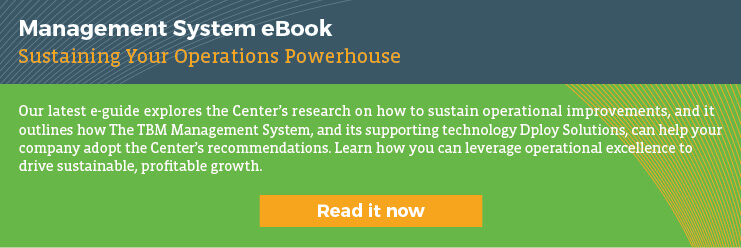Make Your Strategic Vision Something Everyone Can Understand, Own, and Support
From the C-suite, your organization’s strategic vision might be clear as day. But on the shop floor, it’s often a different story. Research by the National Center for the Middle Market and Dr. Peter Ward, a professor of operational management at The Ohio State University Fisher College of Business, shows that only 17% of mid-sized firms and 6% of larger organizations strongly agree that people at all levels of the organization can articulate how their work relates to organizational strategy.
If your people don’t know why they’re doing what they’re doing, then how can they be expected to meaningfully contribute to your organization’s goals? The answer is, they can’t. The same research report shows that fewer than one in five executives strongly agrees that projects are filtered for priority and fit with the organization’s strategy.
Clearly, companies have some work to do when it comes to getting their operations people on board with the bigger picture. According to the Center, when companies invest in their strategic subsystem and find ways to interpret the organization’s strategy down to the shop floor, they will be in a much better position to make and sustain operational improvements long term.
A Formal Management System Can Help Connect Your People to Your Strategic Vision
The Center’s research suggests that companies that adopt formal management methodologies do better at improving all areas of their operations and sustaining operational gains. Looking specifically a strategy, a formalized approach can help companies better cascade strategy to all levels of the organization and ensure that projects are prioritized and aligned with the company’s overall goals.
In many ways, the TBM Management System fits hand in glove with the Center’s recommendations. It helps companies connect big picture strategy with day-to-day goals and objectives that can be easily understood and implemented organization-wide. Here’s how it works:
- The TBM Management System links strategy to action. The approach walks leaders through a process of identifying aggressive, long-term goals, such as driving double-digit growth over three years without increasing resources. Then it helps managers break down those goals into annual objectives, create action plans with measurable targets, and assign resources to execute the plans.
- It surfaces the critical few KPIs. The Management System helps leaders focus on the most important performance indicators, tie those KPIs to specific projects, and ensure the entire organization understands what matters most.
- It creates a map from here to there. Once goals and KPIs are defined, the next step is to create detailed roadmaps that guide operations people to their success, while illustrating how their work relates to larger corporate objectives. Everyone understands how their contributions matter to the organization, and they take greater pride in their roles as a result.
When Everyone Is Working Toward the Same Goals, Unprecedented Results Are Possible.
Just ask Carlisle Companies, a global diversified industrial manufacturer with five major operating businesses and 75 facilities worldwide. When the company implemented the their version of the TBM Management System (the Carlisle Operating System), it went from having weak linkage between strategy and execution to having the entire enterprise focused on specific targets tied directly to corporate objectives. TBM helped Carlisle to implement its operating system nearly 10 years ago and still provides adhoc support for targeted improvements as needed. The organization continues to post record performance as a result of its commitment to their strategic alignment and operating system. Read the management system story here.
A Formal Approach to Strategy Can Help You Sustain Your Operational Gains
Translating strategic vision so that it’s relevant and relatable to your entire operations team can go a long way toward getting your organization closer to the breakthrough performance it envisions. A formal approach, such as the TBM Management System, can help you improve other facets of operations as well, including daily management, problem-solving, and people development. When each of these operational subsystems are optimized, the Center’s research suggests that companies can not only make greater gains; they can sustain them long term.
New Management System eGuide Available Now
To learn more about how to drive sustainable operational excellence, download our e-guide today.





